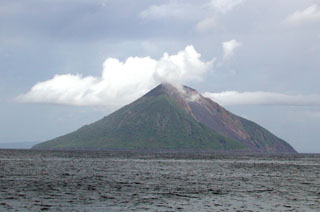Report on Tinakula (Solomon Islands) — October 2009
Bulletin of the Global Volcanism Network, vol. 34, no. 10 (October 2009)
Managing Editor: Richard Wunderman.
Tinakula (Solomon Islands) Eruption suggested by satellite thermal data and confirmed in the field
Please cite this report as:
Global Volcanism Program, 2009. Report on Tinakula (Solomon Islands) (Wunderman, R., ed.). Bulletin of the Global Volcanism Network, 34:10. Smithsonian Institution. https://doi.org/10.5479/si.GVP.BGVN200910-256010
Tinakula
Solomon Islands
10.386°S, 165.804°E; summit elev. 796 m
All times are local (unless otherwise noted)
MODIS/MODVOLC satellite thermal alerts data for Tinakula (table 4) suggests continuing eruptive activity during the period mid-June 2007 through [mid-August] 2009; however, these data lack validation by field observations. Similar intermittent alerts have been detected since mid-February 2005 (BGVN 31:03, 32:03, and 32:07).
Table 4. MODIS/MODVOLC satellite thermal alerts measured at Tinakula during the period mid-June 2007 through early December 2009 (continued from table in BGVN 32:07). [Pixels originally reported on 15 February and 4 May could not be confirmed and may have been included by mistake.] Courtesy of the Hawai'i Institute of Geophysics and Planetology (HIGP) Thermal Alerts System.
| Date | Time (UTC) | Pixels | Satellite |
| 24 Sep 2007 | 1140 | 2 | Terra |
| 19 Oct 2007 | 1430 | 1 | Aqua |
| 09 Nov 2007 | 1150 | 1 | Terra |
| 19 Sep 2008 | 1130 | 1 | Terra |
| 26 Sep 2008 | 1140 | 1 | Terra |
| 04 Nov 2008 | 1145 | 1 | Terra |
| 29 Nov 2008 | 1440 | 2 | Aqua |
| 12 Aug 2009 | 1140 | 1 | Terra |
| 14 Aug 2009 | 1125 | 1 | Terra |
A possible observation of eruptive activity was found on a website by Clark Berge dated 22 September 2009: "A tall plume of steam and smoke streams from the top of a majestic cone rising direct from the sea.... During my visit to Temotu Province last week ... we circled [Tinakula in a motorized canoe], which seemed lush and harmless until we rounded a point and saw the steep black face of stone. Boulders were detaching themselves and bounding down the cliff amid a shower of sparks. I quickly realized the stones were glowing red!"
Geological Summary. The small 3.5-km-wide island of Tinakula is the exposed summit of a massive stratovolcano at the NW end of the Santa Cruz islands. It has a breached summit crater that extends from the summit to below sea level. Landslides enlarged this scarp in 1965, creating an embayment on the NW coast. The Mendana cone is located on the SE side. The dominantly andesitic volcano has frequently been observed in eruption since the era of Spanish exploration began in 1595. In about 1840, an explosive eruption apparently produced pyroclastic flows that swept all sides of the island, killing its inhabitants. Recorded eruptions have frequently originated from a cone constructed within the large breached crater. These have left the upper flanks and the steep apron of lava flows and volcaniclastic debris within the breach unvegetated.
Information Contacts: Hawai'i Institute of Geophysics and Planetology (HIGP) Thermal Alerts System, School of Ocean and Earth Science and Technology (SOEST), Univ. of Hawai'i, 2525 Correa Road, Honolulu, HI 96822, USA (URL: http://modis.higp.hawaii.edu/); Clark Berge (URL: http://brclarkberge.blogspot.com/2009/09/tinakula-volcanoe.html).

